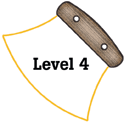|
National Science Education Standards
The total energy of the universe is constant. Energy can be transferred
by collisions in chemical and nuclear reactions, by light waves and other
radiations, and in many other ways. However, it can never be destroyed.
As these transfers occur, the matter involved becomes steadily less ordered.
(Page 180)
All energy can be considered to be either kinetic energy, which is the
energy of motion; potential energy, which depends on relative position;
or energy contained by a field, such as electromagnetic waves. (Page 180)
Waves, including sound and seismic waves, waves on water, and light
waves, have energy and can transfer energy when they interact with matter.
(Page 180)
Each kind of atom or molecule can gain or lose energy only in particular
discrete amounts and thus can absorb and emit light only at wavelengths
corresponding to these amounts. These wavelengths can be used to identify
the substance. (Page 180)
|
|
Benchmarks
Whenever the amount of energy in one place or form diminishes, the amount
in other places or forms increases by the same amount. (Page 86)
Transformations of energy usually produce some energy in the form of
heat, which spreads around by radiation or conduction into cooler places.
Although just as much total energy remains, its being spread out more
evenly means less can be done with it. (Page 86)
|


